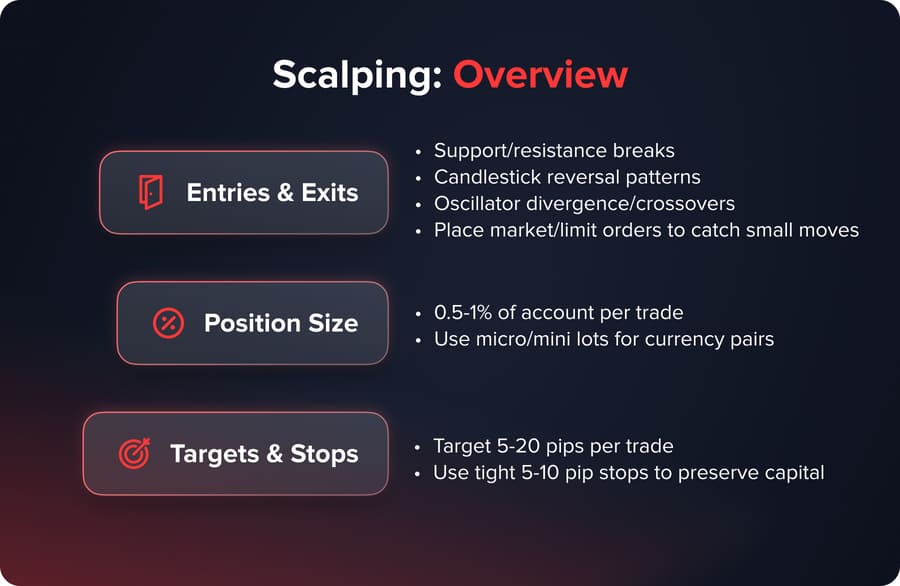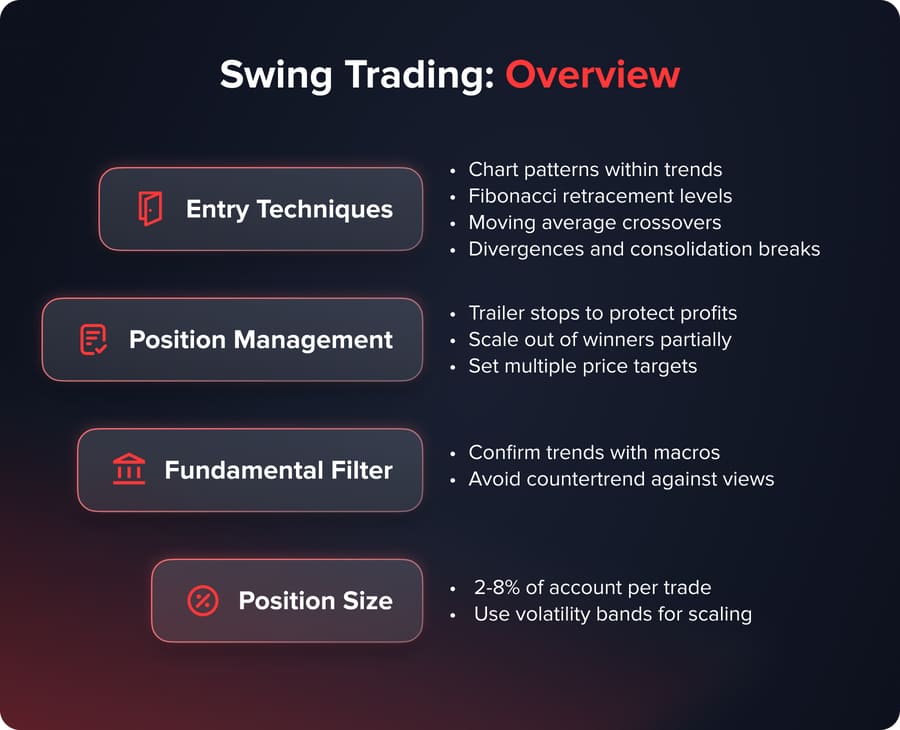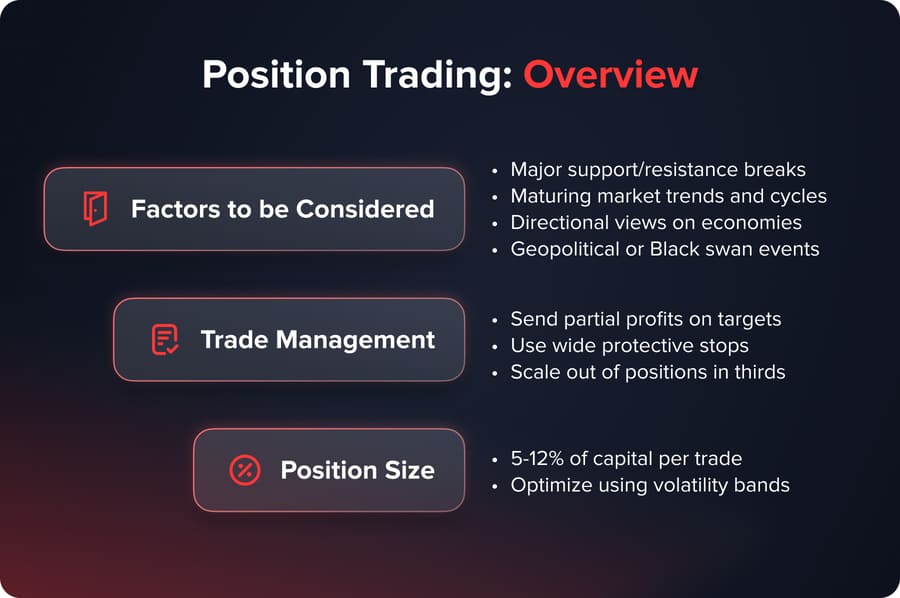
Chiến lược giao dịch Forex tốt nhất năm 2024
Mục lục
Chiến lược giao dịch Forex tốt nhất năm 2024:
- Đầu cơ
- Giao dịch trong ngày
- Giao dịch lướt sóng
- Giao dịch theo vị thế
Tại sao chiến lược giao dịch Forex lại quan trọng?
Để tránh những cạm bẫy này và tối đa hóa tuổi thọ, việc tập trung năng lượng suy nghĩ kỹ lưỡng vào việc phát triển chiến lược ngay từ đầu sẽ mang lại lợi ích to lớn. Một hệ thống tốt sẽ thiết lập khuôn khổ cần thiết để đưa ra quyết định khách quan, ngay cả khi xảy ra tình trạng hòa vốn là điều không thể tránh khỏi trong giao dịch theo thời gian.
Với suy nghĩ này, sau đây là một số lý do chính tại sao việc có một chiến lược rõ ràng lại đóng vai trò là xương sống của một doanh nghiệp giao dịch:
- Nếu không có chiến lược rõ ràng, những cảm xúc như sợ hãi và tham lam có thể tác động tiêu cực đến quyết định giao dịch. Chiến lược cung cấp các quy tắc khách quan để tuân theo.
- Việc sụt giảm là không thể tránh khỏi, nhưng các chiến lược vẫn duy trì được tính kỷ luật ngay cả trong giai đoạn thua lỗ thông qua các biện pháp kiểm soát rủi ro được xác định trước và các thông số về quy mô vị thế.
- Chiến lược thiết lập các quy tắc vào lệnh và thoát lệnh rõ ràng, khóa giao dịch vào vùng lợi nhuận và dừng lỗ nhất quán. Điều này ngăn ngừa việc thoát lệnh sớm do biến động.
- Nhà giao dịch có thể kiểm tra ngược một cách khách quan các phương pháp tiếp cận chiến lược khác nhau để xác định các hệ thống có xác suất cao hơn và các lĩnh vực cần cải thiện thông qua kết quả định lượng.
- Các chiến lược cho phép tập trung vào các cơ hội giao dịch có lợi nhuận cao phù hợp với xu hướng và mức độ đã được xác nhận thay vì các quyết định phản ứng với biến động giá ngắn hạn.
- Việc áp dụng phương pháp tiếp cận có hệ thống đã được chứng minh là tạo ra giá trị kỳ vọng tích cực thông qua thử nghiệm giúp các nhà giao dịch có lợi thế hơn so với các nhà giao dịch theo quyết định riêng trong thời gian dài.
- Quản lý rủi ro , quy mô vị thế, lập kế hoạch giao dịch và các quy trình đánh giá được kết hợp vào khuôn khổ chiến lược để coi giao dịch là một hoạt động kinh doanh và tối đa hóa lợi nhuận dài hạn.
Đầu cơ

Scalping là việc tham gia và thoát khỏi các giao dịch cực kỳ ngắn hạn trong cùng một phiên giao dịch. Các vị thế thường chỉ được giữ trong vài phút với mục đích kiếm lời từ những biến động giá nhỏ.
Các chiến lược scalping trong năm 2024 sử dụng biểu đồ trong ngày, chẳng hạn như khung thời gian 1 và 5 phút. Các lệnh vào và thoát lệnh thường được thực hiện khi giá phá vỡ các ngưỡng hỗ trợ và kháng cự, cùng với các chỉ báo kỹ thuật cho tín hiệu về trạng thái quá mua hoặc quá bán. Các chỉ báo như chỉ báo dao động ngẫu nhiên (stochastic oscillator), cùng với các chỉ báo khác, thường cho thấy những thay đổi ngắn hạn về động lượng, phù hợp cho việc scalping.
Vị thế của bạn chỉ nên chiếm 1% hoặc ít hơn tổng giá trị tài khoản để giảm thiểu rủi ro trong giao dịch. Bạn có thể thường xuyên sử dụng các khoản lợi nhuận nhỏ, với tỷ lệ rủi ro/lợi nhuận là 1:1 đến 2:1. Chiến lược này đòi hỏi phải theo dõi liên tục biến động thị trường để có thể giao dịch lướt sóng; do đó, nó phù hợp với những nhà giao dịch có nhiều thời gian và sự tập trung để quan sát biến động giá và giao dịch thường xuyên. Mặc dù đòi hỏi nhiều nỗ lực, nhưng chiến lược này ít rủi ro hơn so với các chiến lược khác vì thời gian nắm giữ rất ngắn.
Vào và ra:
- Hỗ trợ/kháng cự bị phá vỡ
- Các mô hình nến đảo chiều
- Phân kỳ/giao thoa của bộ dao động
- Đặt lệnh thị trường/giới hạn để nắm bắt những biến động nhỏ
Kích thước vị trí:
- 0,5-1% tài khoản cho mỗi giao dịch
- Sử dụng lô siêu nhỏ/nhỏ cho các cặp tiền tệ
Mục tiêu và Điểm dừng:
- Mục tiêu 5-20 pip cho mỗi giao dịch
- Sử dụng lệnh dừng lỗ chặt chẽ 5-10 pip để bảo toàn vốn
Mẹo để lướt sóng:
- Chỉ theo dõi 1-3 cặp tiền tệ
- Tự động hóa các mục nhập với cảnh báo chỉ báo
- Da đầu theo hướng xu hướng hàng ngày
Ưu điểm của Scalping:
- Cần vốn nhỏ để bắt đầu
- Lợi nhuận thường xuyên được tích lũy theo thời gian
- Hành động giá dễ học
Nhược điểm của Scalping:
- Yêu cầu thời gian sử dụng màn hình liên tục
- Căng thẳng cao từ nhiều giao dịch hàng ngày
- Dễ dàng giao dịch quá mức trên các tín hiệu nhỏ
Giao dịch trong ngày
Giao dịch trong ngày bao gồm việc mở và đóng lệnh trong một phiên giao dịch. Giao dịch trong ngày chủ yếu diễn ra từ lúc mở cửa buổi sáng đến lúc đóng cửa buổi chiều. Phương pháp này nhằm mục đích nắm bắt những biến động giá trong ngày, chứ không phải xu hướng chung.
Trong năm 2024, khi sử dụng biểu đồ hàng ngày, chúng ta nên tập trung vào các vùng hỗ trợ và kháng cự, cũng như các biến động do tin tức thúc đẩy cho thấy các chỉ báo kỹ thuật về sự thay đổi. Hãy thử theo dõi xu hướng khi thị trường mạnh và giao dịch trong phạm vi hẹp khi giá tích lũy. Theo dõi nhiều khung thời gian để kiểm tra tín hiệu đảo chiều.
Rủi ro 1-5% tài khoản cho mỗi giao dịch; đặt mục tiêu tỷ lệ rủi ro/lợi nhuận từ 1:2 đến 1:3 để có lợi nhuận tốt. Thực hành giao dịch trong ngày bằng cách quan sát biến động giá ngắn hạn. Hãy kỷ luật bằng cách lập kế hoạch cho mỗi giao dịch và duy trì mức dừng lỗ chặt chẽ, vì biến động trong ngày tạo ra nhiều rủi ro hơn.
Các mục nhập:
- Đường xu hướng hoặc MA bị phá vỡ
- Sự thoái lui về vùng vào lệnh
- Swing high/low break
- Tín hiệu khuếch đại xung âm lượng
Lối ra:
- Chốt lời ở mức kháng cự hàng ngày
- Di chuyển điểm dừng để hòa vốn hoặc khóa lợi nhuận nhỏ
- Giao dịch theo hướng của khung thời gian lớn hơn
Xác định vị trí:
- 1-3% tài khoản cho mỗi giao dịch
- Tối ưu hóa bằng cách sử dụng tỷ lệ điều chỉnh rủi ro
Sự kiện cơ bản:
- Tin tức thương mại tác động theo hướng
- Sử dụng lệnh dừng lỗ để bảo vệ chống lại lệnh Fakeouts
Lợi ích của giao dịch trong ngày:
- Tận dụng sự biến động ngắn hạn
- Lịch trình linh hoạt phù hợp với nhiều lối sống
- Tiềm năng cho nhiều giao dịch hàng ngày
Thách thức đối với các nhà giao dịch trong ngày:
- Cần nỗ lực tập trung trong mỗi buổi học
- Căng thẳng cao hơn từ biến động trong ngày
- Dễ dàng giao dịch quá mức trên khung thời gian nhỏ
Giao dịch lướt sóng

Giao dịch lướt sóng liên quan đến việc nắm giữ các vị thế trong vài ngày đến vài tuần tại một thời điểm. Chiến lược trung hạn này kết hợp một số yếu tố của cả mục tiêu ngắn hạn và dài hạn.
Trong năm 2024, việc xác định xu hướng sẽ được thực hiện bằng cách sử dụng biểu đồ hàng ngày và hàng tuần. Bên cạnh đó, các tín hiệu vào và thoát lệnh cũng sẽ được hỗ trợ. Các mức thoái lui Fibonacci cung cấp điểm vào lệnh sau các đợt điều chỉnh trong xu hướng. Các mô hình biểu đồ, tam giác và cờ hiệu hoạt động tốt cho các giao dịch lướt sóng khi được hỗ trợ bởi đường trung bình động hoặc các chỉ báo.
Rủi ro 2-10% vốn cho mỗi giao dịch. Ưu tiên tỷ lệ rủi ro/lợi nhuận cao hơn 1:3 vì các biến động giá có thời gian nắm giữ dài hơn để đạt được mục tiêu. Hãy kiên nhẫn và dành vài tuần để phát triển vị thế. Chiến lược này ít căng thẳng hơn so với giao dịch hàng ngày và vẫn có thể mang lại một số giao dịch tiềm năng trong một tháng.
Kỹ thuật xâm nhập:
- Biểu đồ mẫu trong xu hướng
- Mức thoái lui Fibonacci
- Đường trung bình động giao nhau
- Sự phân kỳ và sự phá vỡ hợp nhất
Quản lý vị trí:
- Dừng xe kéo để bảo vệ lợi nhuận
- Mở rộng ra một phần của người chiến thắng
- Đặt nhiều mục tiêu giá
Bộ lọc cơ bản:
- Xác nhận xu hướng bằng macro
- Tránh xu hướng ngược lại với quan điểm
Xác định vị trí:
- 2-8% tài khoản cho mỗi giao dịch
- Sử dụng dải biến động để mở rộng quy mô
Lợi ích của giao dịch Swing:
- Giảm căng thẳng so với giao dịch trong ngày
- Tiềm năng giao dịch nhiều lần mỗi tháng
- Nắm giữ ngắn hạn hơn giao dịch theo vị thế
Thách thức đối với Swing Trader:
- Cần có kỷ luật để tuân thủ kế hoạch
- Cần có kinh nghiệm để đọc khung thời gian
- Mở cửa cho các trục thị trường vĩ mô
Giao dịch theo vị thế

Giao dịch theo vị thế hướng đến các mô hình giao dịch kéo dài nhiều tuần hoặc hàng tháng chịu ảnh hưởng nhiều hơn từ các yếu tố cơ bản ở cấp độ vĩ mô.
Hãy chú ý đến biểu đồ tuần và tháng trong năm 2024. Hãy theo dõi các đợt bứt phá lớn của các đường xu hướng dài hạn và tìm kiếm các thiết lập hỗ trợ phân tích cơ bản của bạn về lãi suất, dữ liệu kinh tế hoặc diễn biến địa chính trị. Hãy xem xét các vị thế được nắm giữ trong một tháng hoặc lâu hơn.
Với khung thời gian dài hơn, hãy nhắm đến lợi nhuận lớn hơn tỷ lệ 1:5, đồng thời hạn chế rủi ro ở mức 5–15% cho mỗi giao dịch. Các chiến lược được thúc đẩy bởi các lý do khác ngoài phân tích kỹ thuật đòi hỏi quản lý rủi ro hợp lý, bao gồm việc giới hạn khối lượng vị thế. Các nhà giao dịch kiên nhẫn và nắm vững các khái niệm kinh tế vĩ mô sẽ rất phù hợp với giao dịch vị thế.
Các yếu tố cần xem xét:
- Sự phá vỡ hỗ trợ/kháng cự chính
- Xu hướng và chu kỳ thị trường đang trưởng thành
- Quan điểm định hướng về nền kinh tế
- Sự kiện địa chính trị hoặc thiên nga đen
Quản lý thương mại:
- Gửi một phần lợi nhuận vào các mục tiêu
- Sử dụng các điểm dừng bảo vệ rộng
- Tỷ lệ ra khỏi vị trí theo phần ba
Các yếu tố về kích thước:
- 5-12% vốn cho mỗi giao dịch
- Tối ưu hóa bằng cách sử dụng dải biến động
Lợi ích của giao dịch theo vị thế:
- Tận dụng các giao dịch nhỏ trên các động thái lớn
- Phù hợp với các nhà giao dịch có thời gian hạn chế
- Giảm nhu cầu giám sát chặt chẽ
Thách thức đối với các nhà giao dịch theo vị thế:
- Yêu cầu phân tích cơ bản mạnh mẽ
- Mở cửa cho những bất ngờ về kinh tế vĩ mô
- Cần kiên nhẫn để xu hướng trưởng thành
You may also like

Những điều quan trọng cần cân nhắc với chiến lược giao dịch của bạn
Mặc dù việc có một chiến lược giao dịch hiệu quả là rất quan trọng đối với một nhà giao dịch ngoại hối, nhưng điều này là chưa đủ để thành công trên thị trường. Bên cạnh chiến lược giao dịch, bạn cũng nên cân nhắc những yếu tố khác, bao gồm tính cách, ảnh hưởng của các yếu tố vĩ mô đến hành trình giao dịch, quản lý vốn và tâm lý.
1. Tính cách của nhà giao dịch
Tính cách của bạn sẽ được phản ánh trong hành trình giao dịch, do đó, mỗi nhà giao dịch phù hợp với các khung thời gian và phương pháp khác nhau. Hãy cân nhắc xem bạn làm việc hiệu quả nhất với giao dịch trong ngày với nhịp độ nhanh hay thích duy trì vị thế trong nhiều tuần. Nhiều người thấy biểu đồ hàng tháng giúp giảm nhiễu nhưng lại đòi hỏi sự kiên nhẫn. Giao dịch swing cân bằng giữa rủi ro và thời gian nắm giữ. Kiểm tra lại các chiến lược dựa trên lịch trình thực tế của bạn để xác định khả năng tương thích. Tính cách và khả năng chịu rủi ro của bạn cũng rất quan trọng - hãy tránh các chiến lược quá rủi ro nếu bạn gặp khó khăn trong việc duy trì kỷ luật.
2. Ảnh hưởng của các yếu tố vĩ mô
Khi phát triển chiến lược Forex, điều quan trọng là phải theo dõi sát sao các xu hướng kinh tế và sự kiện chính trị toàn cầu. Năm 2024, lạm phát sẽ vẫn ở mức cao ở nhiều quốc gia do các ngân hàng trung ương tiếp tục thắt chặt chính sách. Rủi ro địa chính trị cũng có thể ảnh hưởng đến các cặp tiền tệ, vì vậy bạn phải theo dõi sát sao diễn biến tại Ukraine, Đài Loan và các điểm nóng khác.
Trong khi các yếu tố kỹ thuật chi phối biến động giá ngắn hạn, xu hướng dài hạn cuối cùng lại xuất phát từ những yếu tố kinh tế cơ bản này, ảnh hưởng đến cung và cầu. Hãy cập nhật những tin tức quan trọng sắp tới và các cuộc họp của ngân hàng trung ương có khả năng gây ra biến động. Hãy có luận điểm cơ bản về việc liệu một số dữ liệu nhất định có thể củng cố hay làm suy yếu các loại tiền tệ trong danh mục đầu tư của bạn hay không. Theo dõi các dữ liệu quan trọng như tổng sản phẩm quốc nội (GDP), lạm phát, chênh lệch lãi suất và các chỉ số sản xuất, cũng như cách chúng có thể tác động đến các loại tiền tệ chính và phụ.
Giao dịch theo tin tức liên quan đến việc dự đoán phản ứng của thị trường. Một phương pháp là giao dịch theo diễn biến thay vì phản ứng bằng cách đặt lệnh theo hướng dự đoán trước dựa trên các dự báo cơ bản. Tuy nhiên, các mức bội số lớn có thể xảy ra, vì vậy việc kiểm soát rủi ro chặt chẽ là điều cần thiết khi các yếu tố cơ bản là lợi thế của bạn.
3. Quản lý rủi ro và tiền bạc
Quản lý rủi ro hợp lý là yếu tố then chốt để tồn tại trên thị trường Forex đòn bẩy. Các mô hình định cỡ vị thế dựa trên số dư tài khoản, biến động và mức dừng lỗ có thể giúp kiểm soát tình trạng rút vốn. Đặt mục tiêu rủi ro-lợi nhuận hợp lý ít nhất 1:1 cho mỗi giao dịch để đạt được kỳ vọng tích cực. Sử dụng lệnh dừng lỗ rộng hơn mức biến động hàng ngày cho các chiến lược theo xu hướng nhưng nên đặt lệnh dừng lỗ hẹp hơn cho các thị trường biến động mạnh.
Hãy mở rộng các giao dịch thắng thành giao dịch mạnh và để thua lỗ tự nhiên. Cắt các vị thế thắng sớm nếu các yếu tố cơ bản thúc đẩy sự đảo chiều. Nhanh chóng điều chỉnh chiến lược để phù hợp với các điều kiện biến động. Không bao giờ chùn bước trước các lệnh dừng lỗ bất kể lãi hay lỗ. Thua lỗ là điều không thể tránh khỏi, nhưng việc kiểm soát rủi ro hợp lý sẽ giúp bạn trụ vững đủ lâu để đạt được thành công chung.
You may also like

4. Tâm lý học và Kế hoạch thương mại
Kỷ luật cảm xúc cũng quan trọng không kém kỹ năng kỹ thuật. Hãy xây dựng thói quen giao dịch hiệu quả bằng cách xem lại biểu đồ và kế hoạch giao dịch trước khi giao dịch để tránh những phản ứng liều lĩnh trước biến động giá. Sau khi thua lỗ, hãy bình tĩnh lại trước khi phân tích nguyên nhân — đừng để những thất bại khơi mào cho những giao dịch trả thù tiếp theo.
Tài khoản thực hành trước khi giao dịch thực giúp bạn hiểu rõ ngưỡng rủi ro của mình. Một khi đã thiết lập được lợi thế thông qua việc kiểm chứng chiến lược trên giấy tờ, đừng vội vàng thay đổi quy tắc hoặc giao dịch quá nhanh vì sợ hãi hoặc tham lam trên thị trường thực. Hãy nghỉ ngơi định kỳ nếu căng thẳng xuất hiện để tránh kiệt sức, ảnh hưởng đến kỷ luật.
Ghi chép lại từng kế hoạch giao dịch trước, bao gồm điểm vào lệnh, điểm dừng lỗ, mục tiêu và lý do cơ bản, sau đó tuân thủ nghiêm ngặt. Xem xét lại những gì đã hiệu quả và chưa hiệu quả để cải thiện. Xu hướng thường không đáp ứng được kỳ vọng, vì vậy hãy quản lý khối lượng vị thế cho phù hợp - giảm khối lượng giao dịch ngược xu hướng, dự đoán khả năng đảo chiều mạnh có thể xảy ra. Xây dựng niềm tin nhưng vẫn linh hoạt trong bối cảnh môi trường địa chính trị bất ổn năm 2024.
Phần kết luận
Với việc áp dụng các hệ thống giao dịch đã được chứng minh, được thiết kế riêng cho điểm mạnh của bạn, kết hợp với kỹ năng quản lý vốn và rủi ro, việc giao dịch Forex một cách tự tin trong năm 2024 hoàn toàn nằm trong tầm tay. Hãy nhớ rằng, giao dịch Forex là một cuộc đua marathon, không phải chạy nước rút. Việc duy trì sự tham gia trong bối cảnh biến động đòi hỏi sự linh hoạt, nhưng việc duy trì các chiến lược được tối ưu hóa để tạo ra kỳ vọng tích cực đòi hỏi sự quyết tâm cao hơn nữa đối với các quy tắc giao dịch và khả năng kiểm soát rủi ro. Hãy tiếp cận mọi giao dịch và khía cạnh của quy trình với sự cam kết và kiên nhẫn cần thiết cho một sự nghiệp lâu dài và thành công trên thị trường Forex.
Đã cập nhật:
19 tháng 12, 2024



